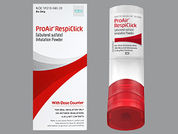Read the Patient Information Leaflet and Instructions for Use provided by your pharmacist before you start using this medication and each time you get a refill. Follow the illustrated directions for the proper use of this medication. If you have any questions, ask your doctor or pharmacist.
Some brands of this inhaler have a built-in sensor that can store data on its use. This information can be used with a smartphone application (app). Read the manufacturer's information on how to set up and use the app. You do not have to use the app in order for the inhaler to work. You can review the data and share it with your health care provider if you want to.
Inhale this medication by mouth as directed by your doctor, usually every 4 to 6 hours as needed. The dosage is based on your medical condition and response to treatment. Do not increase your dose or use this drug more often than prescribed without your doctor's approval. Using too much of this medication will increase your risk of serious (possibly fatal) side effects.
If you are using this medication to prevent asthma brought on by exercise, use it 15 to 30 minutes before exercise.
Do not use a spacer with this inhaler and do not open the cap unless you are ready to take a dose.
Before use, hold the inhaler upright and open the cap. You should hear a click, which means the inhaler is ready for use. Place the mouthpiece near your mouth and breathe out as far as is comfortable. Do not breathe into the inhaler device. Then put the mouthpiece in your mouth, close your lips around it, and breathe in steadily and deeply. Hold your breath for about 10 seconds, or for as long as is comfortable. Close the cap after each use.
Clean the outside of the mouthpiece with a dry tissue or cloth as needed. Do not use water or any other liquid for cleaning. If liquid gets into the inhaler, it may not work properly. Replace the inhaler if it has been washed or placed in water.
If a child is using this medication, a parent or other responsible adult may need to help the child use the inhaler properly.
If you are using other inhalers at the same time, wait at least 1 minute between the use of each medication.
Always have this quick-relief inhaler with you. Keep track of the number of inhalations used from each device. Discard the device after you have used the number of inhalations marked on the manufacturer's package.
Learn which of your inhalers you should use every day (controller drugs) and which you should use if your breathing suddenly worsens (quick-relief drugs). Ask your doctor ahead of time what you should do if you have new or worsening cough or shortness of breath, wheezing, increased sputum, worsening peak flow meter readings, waking up at night with trouble breathing, if you use your quick-relief inhaler more often (more than 2 days a week), or if your quick-relief inhaler does not seem to be working well. Learn when you can treat sudden breathing problems by yourself and when you must get medical help right away.
Tell your doctor if your symptoms do not get better or if they get worse.
